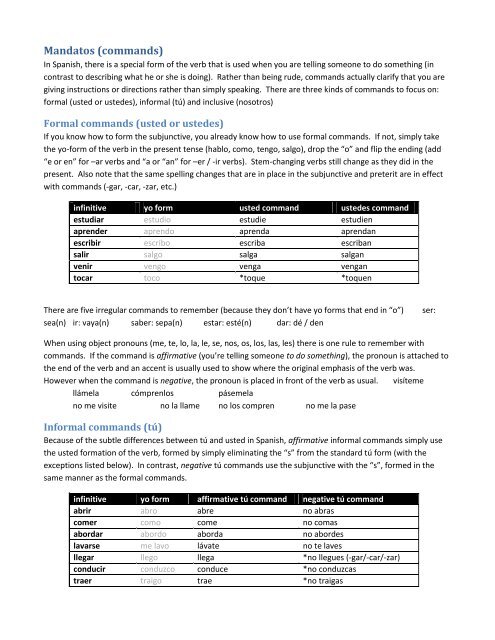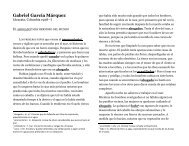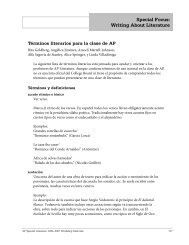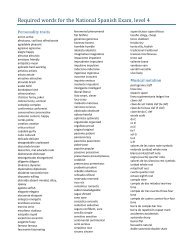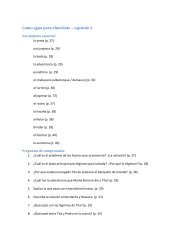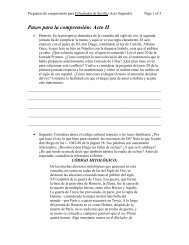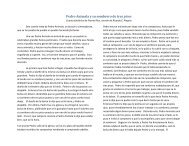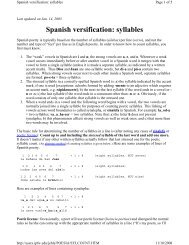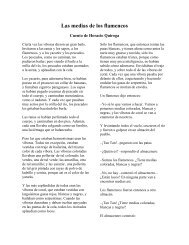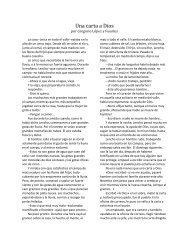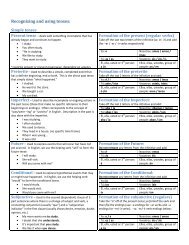Mandatos (commands) - tatespanish.com
Mandatos (commands) - tatespanish.com
Mandatos (commands) - tatespanish.com
Create successful ePaper yourself
Turn your PDF publications into a flip-book with our unique Google optimized e-Paper software.
<strong>Mandatos</strong> (<strong><strong>com</strong>mands</strong>)<br />
In Spanish, there is a special form of the verb that is used when you are telling someone to do something (in<br />
contrast to describing what he or she is doing). Rather than being rude, <strong><strong>com</strong>mands</strong> actually clarify that you are<br />
giving instructions or directions rather than simply speaking. There are three kinds of <strong><strong>com</strong>mands</strong> to focus on:<br />
formal (usted or ustedes), informal (tú) and inclusive (nosotros)<br />
Formal <strong><strong>com</strong>mands</strong> (usted or ustedes)<br />
If you know how to form the subjunctive, you already know how to use formal <strong><strong>com</strong>mands</strong>. If not, simply take<br />
the yo-form of the verb in the present tense (hablo, <strong>com</strong>o, tengo, salgo), drop the “o” and flip the ending (add<br />
“e or en” for –ar verbs and “a or “an” for –er / -ir verbs). Stem-changing verbs still change as they did in the<br />
present. Also note that the same spelling changes that are in place in the subjunctive and preterit are in effect<br />
with <strong><strong>com</strong>mands</strong> (-gar, -car, -zar, etc.)<br />
infinitive yo form usted <strong>com</strong>mand ustedes <strong>com</strong>mand<br />
estudiar estudio estudie estudien<br />
aprender aprendo aprenda aprendan<br />
escribir escribo escriba escriban<br />
salir salgo salga salgan<br />
venir vengo venga vengan<br />
tocar toco *toque *toquen<br />
There are five irregular <strong><strong>com</strong>mands</strong> to remember (because they don’t have yo forms that end in “o”)<br />
sea(n) ir: vaya(n) saber: sepa(n) estar: esté(n) dar: dé / den<br />
ser:<br />
When using object pronouns (me, te, lo, la, le, se, nos, os, los, las, les) there is one rule to remember with<br />
<strong><strong>com</strong>mands</strong>. If the <strong>com</strong>mand is affirmative (you’re telling someone to do something), the pronoun is attached to<br />
the end of the verb and an accent is usually used to show where the original emphasis of the verb was.<br />
However when the <strong>com</strong>mand is negative, the pronoun is placed in front of the verb as usual. visíteme<br />
llámela cómprenlos pásemela<br />
no me visite no la llame no los <strong>com</strong>pren no me la pase<br />
Informal <strong><strong>com</strong>mands</strong> (tú)<br />
Because of the subtle differences between tú and usted in Spanish, affirmative informal <strong><strong>com</strong>mands</strong> simply use<br />
the usted formation of the verb, formed by simply eliminating the “s” from the standard tú form (with the<br />
exceptions listed below). In contrast, negative tú <strong><strong>com</strong>mands</strong> use the subjunctive with the “s”, formed in the<br />
same manner as the formal <strong><strong>com</strong>mands</strong>.<br />
infinitive yo form affirmative tú <strong>com</strong>mand negative tú <strong>com</strong>mand<br />
abrir abro abre no abras<br />
<strong>com</strong>er <strong>com</strong>o <strong>com</strong>e no <strong>com</strong>as<br />
abordar abordo aborda no abordes<br />
lavarse me lavo lávate no te laves<br />
llegar llego llega *no llegues (-gar/-car/-zar)<br />
conducir conduzco conduce *no conduzcas<br />
traer traigo trae *no traigas
Note that pronouns are used in the same positions as with formal <strong><strong>com</strong>mands</strong>: attached to affirmative<br />
<strong><strong>com</strong>mands</strong> (with accent) and in front of negative <strong><strong>com</strong>mands</strong>.<br />
There are a group of irregular informal <strong><strong>com</strong>mands</strong> that must be memorized. These highly frequent verbs all<br />
have a short form with affirmative <strong><strong>com</strong>mands</strong> although they all use the traditional subjunctive in the negative<br />
form. Remember “Vin Diesel has ten weapons.” (ven, di, sal, haz, ten, ve, pon, sé)<br />
infinitive affirmative <strong>com</strong>mand negative <strong>com</strong>mand<br />
venir ven no vengas<br />
decir di no digas<br />
salir sal no salgas<br />
hacer haz no hagas<br />
tener ten no tengas<br />
ir ve no vayas<br />
poner pon no pongas<br />
ser sé no seas<br />
Nosotros/as <strong><strong>com</strong>mands</strong><br />
Nosotros/as <strong><strong>com</strong>mands</strong> correspond to the English Let’s. Both affirmative and negative nosotros/as <strong><strong>com</strong>mands</strong><br />
are generally formed by using the first-person plural form of the present subjunctive. Crucemos la calle. Let’s<br />
cross the street.<br />
No crucemos la calle. Let’s not cross the street.<br />
Remember, however, that the affirmative Let’s + [verb] <strong>com</strong>mand may also be expressed with vamos a +<br />
[infinitive]. This can also mean “we’re going to (do something).” Context will help you figure out which is being<br />
used. To express the idea of “let’s go”, simply use “vamos” (not the subjunctive). The subjunctive is used in the<br />
negative to say “let’s not go” (no vayamos al cine).<br />
Object pronouns are always attached to affirmative nosotros/as <strong><strong>com</strong>mands</strong>. A written accent is added to<br />
maintain the original stress. Pronouns are placed in front of negative nosotros/as <strong><strong>com</strong>mands</strong>.<br />
Firmemos el cheque. Firmémoslo.<br />
Escribamos a Ana y Raúl. Escribámosles.<br />
No les paguemos el préstamo.<br />
There are a couple of exceptions with pronouns and nosotros/as <strong><strong>com</strong>mands</strong>. When nos or se are attached to an<br />
affirmative nosotros/as <strong>com</strong>mand, the final –s is dropped from the verb ending.<br />
Sentémonos allí. Démoselo a ella. Mandémoselo a ellos.<br />
The nosotros/as <strong>com</strong>mand form of irse (to go away) is vámonos. Its negative form is no nos vayamos.


